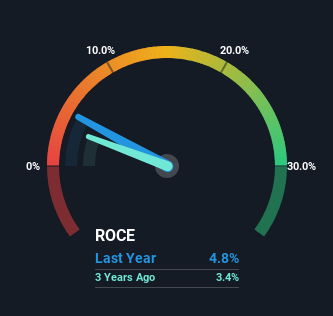The Return Trends At Asian Pay Television Trust (SGX:S7OU) Look Promising
If you're looking for a multi-bagger, there's a few things to keep an eye out for. Firstly, we'll want to see a proven return on capital employed (ROCE) that is increasing, and secondly, an expanding base of capital employed. This shows us that it's a compounding machine, able to continually reinvest its earnings back into the business and generate higher returns. With that in mind, we've noticed some promising trends at Asian Pay Television Trust (SGX:S7OU) so let's look a bit deeper.
Understanding Return On Capital Employed (ROCE)
For those that aren't sure what ROCE is, it measures the amount of pre-tax profits a company can generate from the capital employed in its business. The formula for this calculation on Asian Pay Television Trust is:
Return on Capital Employed = Earnings Before Interest and Tax (EBIT) ÷ (Total Assets - Current Liabilities)
0.048 = S$97m ÷ (S$2.2b - S$146m) (Based on the trailing twelve months to December 2023).
Therefore, Asian Pay Television Trust has an ROCE of 4.8%. Ultimately, that's a low return and it under-performs the Media industry average of 7.5%.
Check out our latest analysis for Asian Pay Television Trust
Historical performance is a great place to start when researching a stock so above you can see the gauge for Asian Pay Television Trust's ROCE against it's prior returns. If you're interested in investigating Asian Pay Television Trust's past further, check out this free graph covering Asian Pay Television Trust's past earnings, revenue and cash flow.
So How Is Asian Pay Television Trust's ROCE Trending?
It's nice to see that ROCE is headed in the right direction, even if it is still relatively low. The data shows that returns on capital have increased by 22% over the trailing five years. The company is now earning S$0.05 per dollar of capital employed. In regards to capital employed, Asian Pay Television Trust appears to been achieving more with less, since the business is using 25% less capital to run its operation. If this trend continues, the business might be getting more efficient but it's shrinking in terms of total assets.
What We Can Learn From Asian Pay Television Trust's ROCE
In the end, Asian Pay Television Trust has proven it's capital allocation skills are good with those higher returns from less amount of capital. Given the stock has declined 29% in the last five years, this could be a good investment if the valuation and other metrics are also appealing. That being the case, research into the company's current valuation metrics and future prospects seems fitting.
If you'd like to know more about Asian Pay Television Trust, we've spotted 3 warning signs, and 2 of them are potentially serious.
If you want to search for solid companies with great earnings, check out this free list of companies with good balance sheets and impressive returns on equity.
Have feedback on this article? Concerned about the content? Get in touch with us directly. Alternatively, email editorial-team (at) simplywallst.com.
This article by Simply Wall St is general in nature. We provide commentary based on historical data and analyst forecasts only using an unbiased methodology and our articles are not intended to be financial advice. It does not constitute a recommendation to buy or sell any stock, and does not take account of your objectives, or your financial situation. We aim to bring you long-term focused analysis driven by fundamental data. Note that our analysis may not factor in the latest price-sensitive company announcements or qualitative material. Simply Wall St has no position in any stocks mentioned.

 Yahoo Finance
Yahoo Finance 
